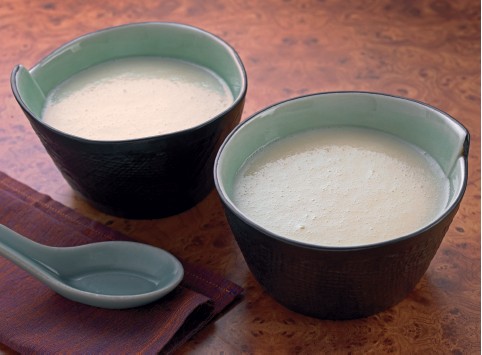
Shredded Chicken with Garlic Vinegar Dressing
A very tasty way of serving chicken—and it’s very easy to prepare. The recipe here comes from the home kitchen of a Shantung family in Taiwan.
4 cups (1 liter) water
3 boneless chicken breasts, skin removed
50 g (1 cup) coarsely chopped coriander leaves
5 cloves garlic, thinly sliced
½ head iceberg lettuce, finely shredded
Sauce
2 tablespoons rice vinegar
2 teaspoons sugar
1 teaspoon salt
2 tablespoons sesame oil
3 teaspoons yellow mustard
2 teaspoons soy sauce
1 Bring the water to a boil in a pot. Add the chicken breasts, cover with a lid, lower the heat and simmer for 8 minutes. Turn off the heat and let the chicken poach in the hot water for 12 more minutes. Remove the chicken and set aside to drain in a colander.
2 Place the Sauce ingredients in a bowl and mix well.
3 Finely shred the cooled chicken breasts and place in a large bowl. Add the chopped coriander leaves and sliced garlic and toss. Then add the Sauce and toss again until the chicken is well coated.
4 Arrange the shredded lettuce on a platter and place the shredded chicken on top.
Serves 3–4
Preparation time: 20 mins
Cooking time: 30 mins

Crispy Sweet Walnuts with Sesame Seeds
Walnuts are a popular ingredient for sweet dishes in northern China, both for their great flavor as well as for their nutritional value. They have a relaxing effect on the nervous system and are often eaten to improve sleep. The recipe below is a traditional northern Chinese favorite dessert and can also be served as an appetizer or bar snack.
150 g (1½ cups) shelled walnuts
1 cup (250 ml) water
3 tablespoons sugar
4 tablespoons honey
Oil, for deep-frying
40 g (⅓ cup) toasted sesame seeds
1 Place the walnuts in a small saucepan, cover with the water, bring to a boil and simmer for 1 minute. Remove the walnuts with a slotted spoon, reserving the water. When cooled, peel off the brown skins.
2 Return the peeled walnuts to the pan, add the sugar and honey, bring to a boil, then reduce the heat and simmer for 10 more minutes. Remove the walnuts with a slotted spoon and set aside in a colander to drain and cool.
3 Heat the oil in a wok until medium-hot, add the walnuts and deep-fry them until golden brown, 6–8 minutes. Remove and drain on paper towels.
4 When the walnuts are cool, place them on a serving plate, sprinkle with the toasted sesame seeds and serve.
Makes 1½ cups
Preparation time: 10 mins
Cooking time: 20 mins
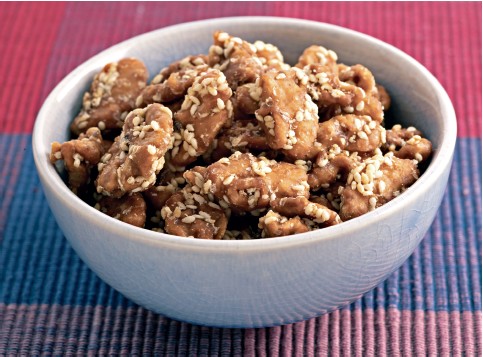
Soft Tofu with Preserved Eggs
The piquant flavor of preserved eggs enlivens the bland taste of the tofu. Very popular in northern China as an appetizer, the recipe here is the traditional way of preparation, complete with sesame oil, spring onion and garlic flavors.
1 cake soft tofu (about 300 g/10 oz)
2 preserved eggs, peeled
1 spring onion, finely chopped
Fresh coriander leaves
Sauce
2 cloves garlic, minced
1 teaspoon sugar
1 teaspoon salt
2 teaspoons soy sauce
1 tablespoon sesame oil
1 Slice the tofu into thin slices and place them on a plate or shallow bowl. Cut each egg into eight sections and arrange on top and around the tofu.
2 Mix together all the Sauce ingredients. Pour it onto the egg and tofu. Sprinkle the spring onions and coriander leaves on top and serve.
For a pungent flavor, add 1 finely chopped red finger-length chili to the Sauce.
Serves 4
Preparation time: 10 mins

Pressed Tofu with Spicy Sauce
Pressed tofu is frequently used in northern Chinese cuisine. In this recipe it is combined with a spicy sauce to make the tofu more appetizing.
6 squares pressed tofu (taukwa)
1 spring onion, thinly sliced
1 red finger-length chili, deseeded, finely sliced
3 cloves garlic, chopped
1 teaspoon salt
1 teaspoon sugar
2 teaspoons rice vinegar
2 teaspoons soy sauce
2 tablespoon sesame oil
1 Blanch the pressed tofu in a pot of boiling water for 5 minutes, then remove and drain. When cool, cut each square in half horizontally to form two thin squares, then slice into thin strips.
2 Place the tofu strips in a bowl with the thinly sliced spring onion, sliced red chili and chopped garlic. Toss to mix well, then add the seasonings and toss well to blend all flavors. Set aside to marinate for 15 minutes. Transfer to a serving platter and serve.
The spring onion may be replaced with finely sliced green bell peppers, leeks or coriander leaves and any of these may be added along with the spring onion.
Serves 6–8
Preparation time: 20 mins
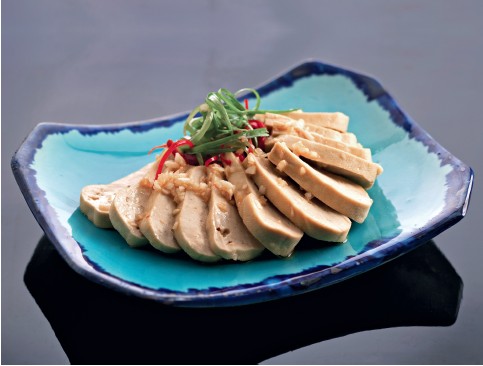
Marinated Cilantro with Peanuts
Coriander leaves (also known as cilantro) is usually used as a garnish or seasoning but becomes the primary ingredient in this unusual appetizer.
500 g (1 lb) coriander leaves (cilantro), roots and tough lower stalks removed, washed
75 g (½ cup) roasted peanuts, chopped
Sauce
2 tablespoons sesame oil
1 tablespoon soy sauce
1 tablespoon rice vinegar
1 tablespoon sugar
½ teaspoon salt
2 cloves garlic, smashed and finely minced
1 Bring a pot of water to a boil and poach the coriander leaves for 1½ minutes. Quickly remove with a slotted spoon and drain in a colander. When cool, squeeze out as much of the liquid as possible. Chop coarsely and place into a bowl with the chopped peanuts.
2 Mix all the Sauce ingredients together and pour over the chopped coriander leaves. Mix well. Set aside to marinate for 20 minutes or place in the refrigerator to chill until ready to serve.
Chopped red chili may be added to the Sauce for an additional pungent flavor.
Serves 4–6
Preparation time: 10 mins
Cooking time: 20 mins

Cucumber Salad with Garlic Sauce
This recipe works well with small slender Japanese or English hothouse cucumbers.
4 Japanese or 2 English hothouse cucumbers
6 cloves garlic, smashed (not chopped) with flat edge of knife
2 teaspoons salt
3 teaspoons sugar
1 tablespoon rice vinegar
2 tablespoons sesame oil
1 Cut the ends off the cucumbers, smash them on a board with the flat side of a cleaver and slice them into 3-cm (1¼-in) chunks. Place in a bowl with the smashed garlic.
2 Add the seasonings and toss well to mix the flavors. Set aside to marinate for 25–30 minutes, then serve or keep chilled in the refrigerator until ready to serve.
If using hothouse cucumbers, deseed the cucumbers before cutting. For a spicier taste, 1 or 2 chopped red finger-length chilies may also be added. Some chefs also add chopped spring onions or coriander.
Serves 4
Preparation time: 10 mins + marinating time
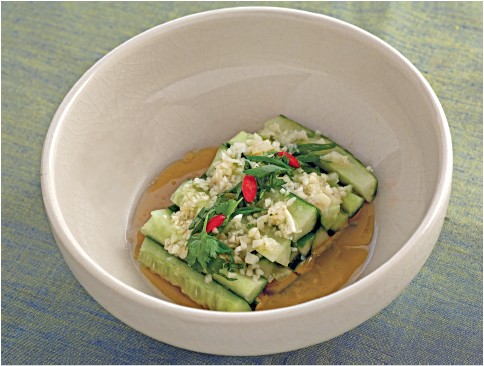
Pot Sticker Dumplings (Guo Tieh)
Pot Stickers are the classic northern Chinese dumplings—first fried in oil then steamed, all in the same pan. The recipe given here use minced pork, but they may also be prepared with vegetables, lamb, chicken or fish.
15–20 round wonton skins
1 tablespoon oil, for frying
1 tablespoon plain flour mixed with 1 cup (250 ml) water
Filling
4 dried black Chinese mushrooms, soaked in hot water for 20 minutes then drained, tough stems discarded, caps chopped
300 g (10 oz) minced pork, chicken or lamb
3 spring onions or garlic chives, finely chopped
3 slices ginger, very finely minced
1 teaspoon salt 1 teaspoon ground black pepper
½ tablespoon sugar
1 tablespoon soy sauce
2 teaspoons sesame oil
1 Make the Filling by placing the chopped mushrooms in a large bowl with the minced meat, spring onions or garlic chives, and ginger. Mix well. Add the seasonings and mix well to combine.
2 Lay the wonton skins on a floured surface. Place 1 tablespoon of the Filling onto the center of each wonton skin and lightly brush around the edges with water. Fold one side of the skin over the Filling to meet the other side, creating a half moon shape, and press the edges together. Press the bottom of each dumpling down to flatten, so the dumplings can sit upright.
3 Heat the oil in a non-stick pan over medium heat. Gently fry the dumplings until crisp on the bottom, about 3 minutes. Add the flour water to the pan, cover with a lid and let it steam for 10–12 minutes or until the liquid has just evaporated. Transfer the cooked dumplings to a serving platter and serve with various table condiments, such as chili sauce or chili oil, black Chinese vinegar and fresh ginger strips.
Makes 15–20 dumplings
Preparation time: 30 mins
Cooking time: 15 mins
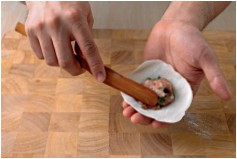
Place 1 tablespoon of the Filling onto the center of each wonton skin.

Fold one side of the skin over the Filling to meet the other side, creating a half moon shape, then press the edges together.

Spring Onion and Garlic Chive Dumplings
This is a typical northern Chinese dish—a wrapper made of wheat flour stuffed with spring onions, garlic chives, egg and glass noodles and then pan-fried. The parcels may be prepared in advance, then fried just before serving.
300 g (2 cups) all-purpose flour
⅔ cup (150 ml) boiling water
⅓cup (80 ml) cool water
Flour, for dusting
1 tablespoon oil, for frying
Stuffing
5 eggs
7 spring onions, finely chopped
1 tablespoon sesame oil
300 g (10 oz) garlic chives, finely chopped
1 small bundle (25 g) dried glass noodles (tang hoon), soaked for 5 minutes until soft, drained and cut into short lengths
1½ tablespoons soy sauce
1 teaspoon salt
1 teaspoon ground black pepper
1 teaspoon sugar
1 First make a dough by sifting the flour into a mixing bowl. Add the boiling water and mix well with a wooden spoon. Then add the cool water, mix to blend. Knead well for about 5 minutes or until a firm dough is formed. Remove the dough from the bowl and wrap it with cling wrap. Set aside for 25 minutes to rest.
2 Prepare the Stuffing by beating the eggs well. Add the spring onions. Heat the sesame oil in a pan over medium heat and quickly stir-fry (scramble) the eggs until done. Add the chives and glass noodles, stir well to mix. Add the seasonings and stir well to blend. Transfer the Stuffing to a clean bowl.
3 Dust a clean work surface and rolling pin with flour. Roll out the dough into a long cylinder about 5 cm (2 in) thick. Cut the cylinder into pieces about 5 cm (2 in) long. Roll out each piece of dough into a round flat wrapper, about 10 cm (4 in) in diameter. Set aside.
4 Spoon 1 heaping tablespoon of the Stuffing onto each dough wrapper. Fold the wrapper in half over the Stuffing and seal the round edges by pressing them together. Repeat until all the dough and Stuffing are used up.
5 Heat a frying pan or griddle over medium-low heat. Spread 1 tablespoon of oil over the surface. Place the dumplings on the hot pan and fry on both sides until the dough begins to blister and turns golden-brown. Transfer to a serving platter and serve hot with condiments of your choice, such as chili sauce, black Chinese vinegar, ginger strips, etc.
Small dried prawns or ground beef or pork may also be added to the Stuffing. Vegetarians may add finely chopped black Chinese mushroom caps for additional flavor and nutritional value.
Makes 15 dumplings
Preparation time: 1 hour
Cooking time: 20 mins

Tianjin Style Spring Onion Pancakes
This is one of the oldest wheat-based dishes in northern China. The preparation process takes time and patience, but is actually quite easy and the result is always worth the effort. No yeast or baking powder is required. Follow the instructions carefully and you’ll produce a perfect pancake.
300 g (2 cups) all-purpose flour
1 cup (250 ml) hot water
2–3 tablespoons cold water
2 tablespoons sesame oil
12 spring onions, finely chopped
1 teaspoon salt
2 tablespoons oil
1 Sift the flour into a mixing bowl and pour the hot water into the center of the flour, mixing it quickly with a wooden spoon. Then gradually add the cold water, continuing to mix, until a firm dough is formed. Set aside to rest for 10 minutes.
2 Place the dough onto a clean floured work surface and knead vigorously until it is smooth and pliant, about 10 minutes. Roll the dough into a cylinder and cut it into 6 equal pieces. Use a floured rolling pin to roll each piece into a round pancake about 15 cm (6 in) in diameter. Brush the top of each pancake with some of the sesame oil and sprinkle some spring onions and salt on top.
3 Fold each pancake in half, then roll it up into a cigar shape. Pinch the ends closed, hold one end in the palm of one hand and use the other hand to twist the rolled dough into a spiral, pressing the spiral down onto the palm to flatten it.
4 Place each spiral face-up on a floured board and use a floured rolling pin to roll it into a round pancake, about 10 cm (4 in) in diameter. Set each pancake aside after rolling.
5 Heat the oil over medium heat in a non-stick frying pan. Fry the pancakes two or three at a time (depending on size of frying pan) for 3–4 minutes, shaking the pan frequently to prevent sticking and encourage puffing. Turn once and fry the other side for 3–4 minutes, shaking the pan. When done, transfer the pancakes to a plate covered with paper towels and continue to fry the other pancakes in the same manner. Serve warm as an accompaniment to other dishes.
Makes 6 pieces
Preparation time: 35 mins
Cooking time: 8 mins


Brush the top of each pancake with sesame oil and sprinkle some spring onions and salt on top.

Twist the rolled dough into a spiral, pressing the spiral down onto the palm to flatten it.
Boiled Chinese Dumplings (Jiaozi)
Known in Chinese as “water dumplings,” they are similar to Italian ravioli, which were no doubt inspired by this original Chinese model. They are easy to make and simple to cook. A bigger batch of the Stuffing may be prepared in advance and kept frozen in the freezer until needed.
25 round wonton skins
Stuffing
250 g (8 oz) minced pork
1 egg, lightly beaten
2 spring onions, finely chopped
5 cm (2 in) ginger, finely chopped
1 teaspoon salt
¼ teaspoon ground white pepper
2 cloves garlic, finely minced
½ teaspoon sugar
1 tablespoon sesame oil
1 teaspoon rice vinegar
2 teaspoons soy sauce
Condiments
Black Chinese vinegar
Shredded ginger strips
Chili oil
Soy sauce
1 Put all the Stuffing ingredients in a large bowl. Toss to mix well.
2 Lay the wonton skins out on a floured work surface. Place 1½ tablespoons of the Stuffing onto the center of each wonton skin and lightly brush around the edges with water. Fold the edges of the skin together to form a half moon, using your fingers to press the edges firmly to seal the dumpling. Place on a lightly-floured platter and continue until all the wonton skins are used up.
3 Bring a large pot of water to a boil and gently lower the dumplings into the water, in small batches of 10 dumplings at a time. 1 cup (250 ml) of cool water should be added to the pot—to allow the water to return to a full boil—each time a batch of dumplings is being lowered into the water. This is to ensure the dumplings are fully cooked. The dumplings are cooked when they float to the surface. Remove with a slotted spoon and transfer to a serving platter that has been smeared with a thin coat of sesame oil to prevent sticking, then continue cooking the remaining dumplings. Serve hot with the various Condiments.
You may also use finely chopped beef, lamb or chicken for the Stuffing. Vegetarians may add finely chopped black Chinese mushrooms caps instead of meat.
Makes 25 pieces
Preparation time: 30 mins
Cooking time: 10 mins

Pan-fried Vegetable Buns
A typical northern Chinese dish, these wheat-based buns are stuffed with savory ingredients and fried in a flat pan, is served with various table condiments so diners may adjust the flavor to their own preference. The buns are prepared in advance, then fried prior to serving. Ground lamb, pork or chicken may be substituted in place of dried prawns. Vegetarians may add finely chopped black Chinese mushroom caps. In cold weather, the dough should be allowed an extra 15 minutes to rise.
1 cup (250 ml) warm water
1 teaspoon yeast powder
1 teaspoon salt
½ teaspoon sugar
450 g (3 cups) all-purpose flour
Flour, for dusting
2 teaspoons plain flour mixed with ⅔ cup (165 ml) water
1 tablespoon oil, for frying
Stuffing
½ head Chinese (Napa) cabbage, finely chopped
3 spring onions, finely chopped
60 g (½ cup) dried prawns, soaked in warm water, drained and chopped in a blender
1 tablespoon soy sauce
1 tablespoon sesame oil
2 teaspoons ground black pepper
1 teaspoon salt
1 teaspoon sugar
1 Make a dough by pouring the warm water into a bowl and stirring in the yeast, salt and sugar until the sugar completely dissolves. Let it sit for a few minutes to allow the yeast to activate.
2 Sift the flour into a large mixing bowl, add the yeast mixture and mix well until a firm dough is formed. Cover with a damp towel and set aside for 45 minutes to allow the dough to rise.
3 Meanwhile, prepare the Stuffing by combining the cabbage, spring onions and dried prawns in a bowl. Add the seasonings and mix well.
4 Remove the dough from the bowl and placed onto a lightly floured surface. Knead the dough for 5 minutes, then return it to the bowl, cover with a damp towel and set aside to rise for another 30 minutes.
5 When the dough has risen, place it back onto the work surface and knead briefly. With a floured rolling pin, roll it out into a long cylinder about 3 cm (1¼ in) thick. Cut the cylinder into pieces about 3 cm (1¼ in) long and roll each piece into a round flat pancake about 10 cm (4 in) in diameter.
6 Spoon 1 heaping tablespoon of the Stuffing onto the center of each pancake, then pull the edges of the pancake up around the Stuffing to form a bun. Twist the edges together at the top of the bun to seal it.
7 Heat the oil in a non-stick pan over medium-low heat and fry the stuffed buns for about 2 minutes. Pour the flour and water mixture into the pan, cover with a lid and let it steam for 10–12 minutes or until the liquid has just evaporated. Remove from the heat and transfer the buns to a serving platter. Serve hot with various table condiments of your choice.
Serves 4
Preparation time: 45 mins + rising time for dough
Cooking time: 15 mins


Cut the roll into pieces about 3-cm (1¼-in) length. Roll each piece into a round flat pancake.
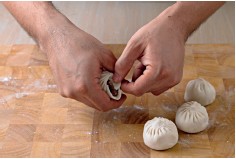
Twist the edges together at the top of the bun to seal it.
Prawn Dumplings in Clear Broth
A variation of the “water dumplings”—this version is prepared with prawn stuffing and served in a broth garnished with sprigs of fresh coriander leaves or parsley.
30 fresh or frozen round wonton skins
25 g (½ cup) coriander leaves
6¼ cups (1.5 liters) chicken stock
1 teaspoon salt
1 teaspoon sesame oil
Stuffing
½ head Chinese (Napa) cabbage, washed, drained and finely chopped
300 g (10 oz) fresh prawns, shells and heads removed, coarsely chopped
6 spring onions, finely chopped
3 slices ginger, finely minced
1 teaspoon ground black pepper
1 teaspoon salt
1 teaspoon sugar
1 tablespoon sesame oil
1 To make the Stuffing, place the chopped cabbage in a bowl with the chopped prawns, spring onions and minced ginger. Toss to mix well. Add the rest of the ingredients and mix well.
2 Lay the wonton skins on a floured work surface. Place 1½ tablespoons of the Stuffing onto the center of each wonton skin and lightly brush around the edges with water. Fold the edges of the skin together to form a half moon, use your fingers to press the edges firmly to seal the dumpling. Place on a lightly-floured platter and continue until all the wonton skins or Stuffing are used up.
3 Bring the chicken stock to a boil in a stockpot and gently lower the dumplings into the stock, in small batches of 10–15 dumplings at a time. The dumplings are cooked when they float to the surface. Remove with a slotted spoon and transfer them to individual bowls. Continue the same process with the remaining dumplings.
4 When all the dumplings have been cooked and removed, add the salt and sesame oil to the stock, stir and ladle the stock over the dumplings in each individual bowl. Garnish with some coriander leaves and serve immediately.
Instead of prawns, these dumplings may also be made with chopped fresh fish, such as perch, sea bass, cod or swordfish. Be sure that the fish is completely deboned and skinned before chopping.
Serves 6
Preparation time: 40 mins
Cooking time: 20 mins
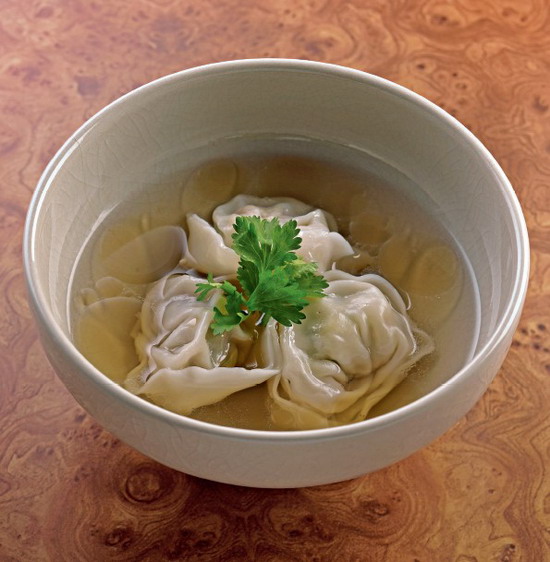

Gently lower the dumplings into the water, in small batches.
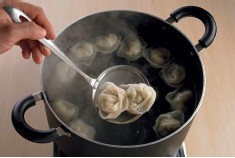
The dumplings are cooked when they float to the surface. Remove with a slotted spoon.
Chicken Soup with Garlic
This is a soup you will not be able to find in any Chinese restaurants today, but it’s still very much a dish of the traditional-minded northern Chinese families, especially in winter. It’s a remedy for colds and acts as a heating tonic to warm up the insides of the body. Highly aromatic and therapeutically potent, this soup is also nutritious, delicious and easy to make. Be sure to use sea salt rather than ordinary salt for this soup, in order to obtain the therapeutic and nutritional benefits.
1 medium whole chicken, preferably free-range, innards removed
10 cloves garlic, skinned but not cut
6¼ cups (1.5 liters) water
3¼ cups (750 ml) rice wine
1 tablespoon sea salt
1 Wash the chicken well, drain and pat-dry with paper towels. Place the garlic into the abdominal cavity of the chicken and close the opening with a few toothpicks or sew it closed with a piece of string.
2 Place the chicken in a large soup pot, add the water, wine and salt. Bring to a boil, then simmer covered over low heat for 1¼ hours.
3 Transfer the whole chicken and all the broth to a large soup tureen and serve immediately. Diners may serve themselves the broth in individual bowls and pick the tender chicken meat loose with their chopsticks at the table or this may be done for them by the host.
Serves 4–6
Preparation time: 20 mins
Cooking time: 1 hr 15 mins

Chinese Cabbage Soup
300 g (10 oz) bok choy or Chinese (Napa) cabbage, cut in half lengthwise
3 dried black Chinese mushrooms, soaked in hot water for 20 minutes then drained
2 cups (500 ml) chicken stock
2 tablespoons sliced ham
60 g (½ cup) dried prawns, soaked in warm water, drained
½ teaspoon salt, or to taste
1 Bring a pot of water to a boil and briefly blanch the vegetables. Drain and chopped into 3-cm (1¼-in) pieces. Halve the mushroom caps if they are large and discard the tough stems.
2 Bring the chicken stock to a boil in a stockpot. Add the ham, mushrooms, dried prawns, vegetables, and salt.
3 Bring the stock back to a boil and skim off any foam from the surface. Reduce the heat and simmer until the vegetables are very tender.
4 Remove from the heat and pour into a soup tureen and serve immediately.
Serves 2–3
Preparation time: 20 mins
Cooking time: 1 hour
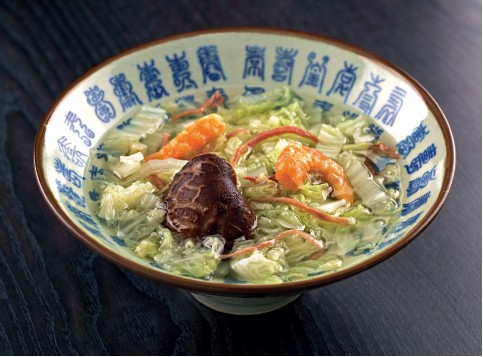
Classic Hot and Sour Soup
4 cups (1 liter) chicken or vegetable stock
1 teaspoon salt
1 teaspoon sugar
½ tablespoon grated ginger
60 g (½ cup) fresh or frozen green peas
1 large tomato, diced
1 cake soft tofu (about 300 g/10 oz), diced
5 dried black Chinese mushrooms, soaked in hot water for 20 minutes then drained, tough stems discarded, caps diced
2 tablespoons soy sauce
2 tablespoons black Chinese vinegar
1 teaspoon sesame oil
½ teaspoon ground black pepper
½ teaspoon ground Sichuan peppercorns or sansho pepper
2 eggs, beaten
2 tablespoons cornflour dissolved in 2 tablespoons water
3 spring onions, sliced
Pinch of ground white pepper
Chili oil, to serve (optional, see note)
Black Chinese vinegar, to serve (optional)
1 Bring the stock to a boil in a large pot. Add the salt, sugar, ginger, peas, tomato, tofu and mushrooms. Return to a boil, reduce the heat and simmer for 3 more minutes.
2 Add the soy sauce, black Chinese vinegar, sesame oil, black pepper and ground Sichuan pepper. Stir to mix well. Slowly drizzle the beaten egg into the soup and let sit for 1 minute. Do not stir.
3 Stir the cornflour mixture, then pour it slowly into the simmering soup while stirring gently. Keep stirring until the soup thickens. Simmer for 1 more minute, then turn off the heat.
4 Serve hot, garnished with spring onions and white pepper. Add a few drops of chili oil and black Chinese vinegar, if desired.
Chili oil is made from dried chilies or chili powder steeped in oil. Bottled chili oil is also available in Asian markets, or you can make your own. Heat ¾ cup (185 ml) of oil in a wok or frying pan and add 1 tablespoon of Sichuan peppercorns and 2 dried chilies (deseeded and sliced). Cook over low heat for 10 minutes, then cool and store in a glass container for 2–3 days. Strain and discard the peppercorns and chilies. Store in an airtight glass jar and keep in a cool place for up to 6 months.
Serves 4
Preparation time: 30 mins
Cooking time: 10 mins
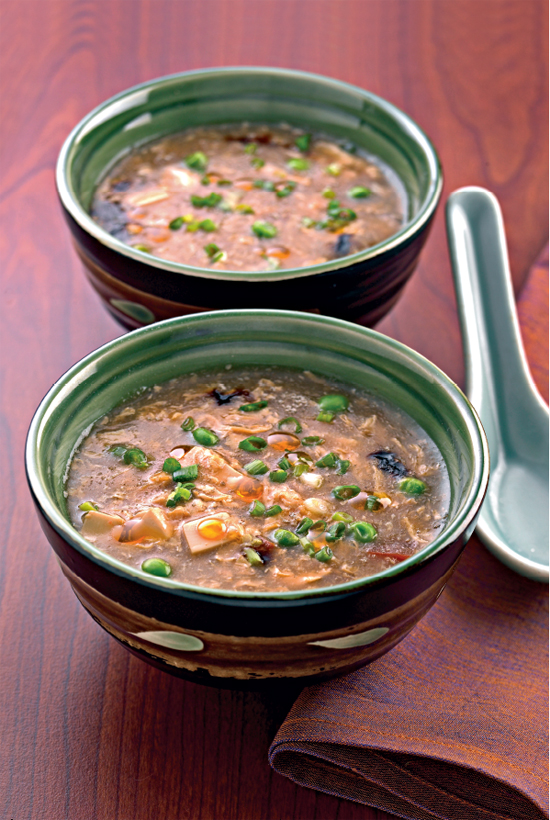
Noodles with Chicken and Garlic Chives
250 g (8 oz) boneless chicken breasts
1 egg white
2½ tablespoons corn-flour dissolved in 1½ tablespoons water
13 tablespoons oil
1 cup (250 ml) chicken stock
200 g (7 oz) garlic chives, washed and cut into 2.5-cm (1-in) sections
1 tablespoon salt, or to taste
500 g (1 lb) fresh wheat noodles or 250 g/8 oz dried wheat noodles
1 Remove the skin from the chicken breasts and finely sliced the meat. Mix the egg white and cornflour mixture into a paste and coat the chicken slices.
2 Heat 4½ tablespoons of oil in a wok. Add the chicken slices and cook, stirring, until they turn white. Turn off the heat and remove the chicken slices with a slotted spoon. Pour out the oil into a small container, reserve for use in step 5.
3 Re-heat the wok. Return the chicken slices to the wok, add the chicken stock, garlic chives and salt. Bring to a boil. Turn off the heat and remove the chicken slices and chives with a slotted spoon and set aside, reserving the chicken stock.
4 Bring a large pot of water to a boil, blanch the noodles briefly to revive them. If using dried noodles, follow the packet instructions or cooked them for 3–4 minutes until the noodles are tender. Drain, rinse in cold water and set aside to drain in a colander.
5 Heat the reserved oil together with another 4½ tablespoons of the remaining oil in a clean wok. Gently tilt the wok to swirl the oil around. Add the noodles in an even layer. Shallow-fry them, swirling the wok so they cook evenly. Fry until browned on one side, then slide the wok scoop or a spatula under the noodles and turn them over. Sprinkle the rest of the oil around the edges and continue to shallow-fry the noodles until browned on the other side. Pour in the reserved chicken stock and simmer, covered, for 1 minute or until the noodles absorb the sauce. Toss the noodles with chopsticks or a fork and add the chicken slices with the chives. Stir, remove and serve immediately.
Serves 4–6
Preparation time: 10 mins
Cooking time: 20 mins
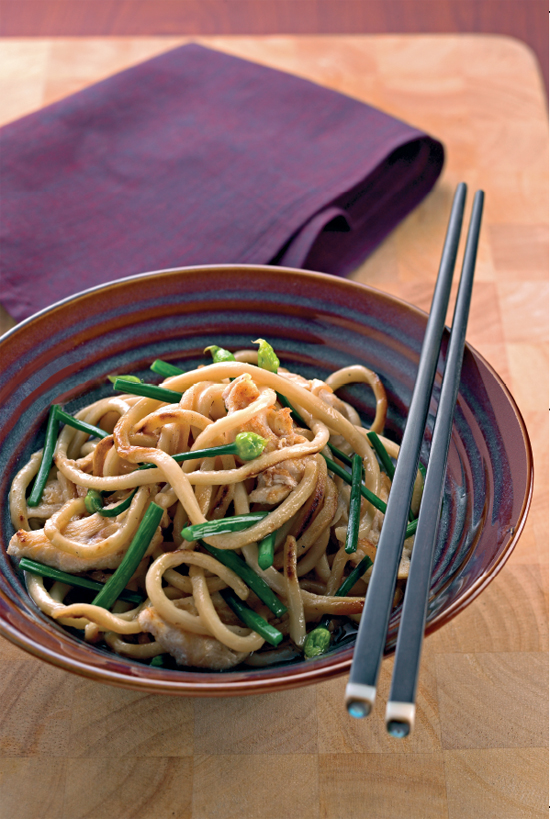
Stir-fried Noodles with Vegetables
A quick and convenient way to prepare a one-pot meal. This recipe works well with fresh wheat noodles.
500 g (1 lb) fresh wheat noodles or 250 g/8 oz dried wheat noodles
3 tablespoons oil
10 dried black Chinese mushrooms, soaked in hot water for 20 minutes then drained, tough stems discarded, caps sliced
4 cloves garlic, peeled and thinly sliced
2 large heads bok choy, cut in half lengthwise and chopped into 3-cm (1¼-in) pieces
1 teaspoon salt
1 teaspoon ground black pepper
1 teaspoon sugar
1 tablespoon tomato sauce or ketchup
1 teaspoon soy sauce
2 teaspoons black Chinese vinegar
1 Bring a large pot of water to a boil, blanch the noodles briefly to revive them. If using dried noodles, follow the packet instructions or cooked them for 3–4 minutes until the noodles are tender. Drain, rinse in cold water and set aside to drain in a colander.
2 Heat the oil in a wok until smoking hot, add the sliced mushrooms and garlic and stir-fry for about 2–3 minutes, then add the bok choy and stir-fry for 3 more minutes.
3 Add the rest of the ingredients and stir-fry quickly to blend all flavors. Add the drained noodles and toss until well mixed.
4 Transfer the noodles and vegetables to a large serving platter or into individual serving bowls and serve immediately.
Other vegetables, such as finely sliced carrot, bell pepper, celery and white onions may also be included in this dish. You may also add finely sliced chicken, in which case the chicken should be added to the wok first, followed by the vegetables. The noodles may be garnished with chopped fresh coriander or parsley and served with various table condiments, such as chili sauce on the side.
Serves 4–6
Preparation time: 15 mins
Cooking time: 20 mins

Chicken Noodles with Mushrooms
A grand northern Chinese noodle dish with a richly flavored, thickly textured gravy and nutritious ingredients.
250 g (8 oz) boneless chicken breast, finely sliced
8 dried black Chinese mushrooms, soaked in hot water for 20 minutes
15 g (1 cup) dried wood ear black fungus, soaked in hot water for 20 minutes
15 g (¾ cup) dried lily buds, bases trimmed, soaked in water for 20 minutes (see note)
500 g (1 lb) fresh wheat noodles or 250 g/8 oz dried noodles
3 tablespoons oil
1½ teaspoons salt
1 tablespoon soy sauce
6¼ cups (1.5 liters) chicken stock or water
1 teaspoon cornflour dissolved in 3 tablespoons water
3 eggs, well beaten
1 teaspoon sesame oil
Marinade
3 tablespoons finely chopped spring onion
1 tablespoon finely minced ginger
2 teaspoons soy sauce
1 tablespoon sesame oil
1 teaspoon cornflour
1 Place the chicken breast with all the Marinade ingredients in a bowl and mix well. Set aside to marinate for 15–20 minutes.
2 Drain the mushrooms, discard the tough stems and thinly sliced the caps. Drain the wood ear fungus and chop finely. Drain the lily buds and tie a knot in the center.
3 Bring a large pot of water to a boil, blanch the noodles briefly to revive them. If using dried noodles, follow the packet instructions or cooked them for 3–4 minutes until the noodles are tender. Drain, rinse in cold water and set aside to drain in a colander. Divide the noodles into individual serving bowls.
4 Heat the oil in a wok until smoking, add the marinated chicken and stir-fry quickly for 1 minute, then add the mushroom, fungus and lily buds and stir-fry for another 2–3 minutes. Add the salt, soy sauce and chicken stock or water, bring to a boil, lower the heat and simmer for 15 minutes more. Stir in the cornflour mixture until the gravy thickens, then drizzle in the beaten eggs, stir once and let the eggs cook for just 1 minute. Turn off the heat. Stir in the sesame oil.
5 Ladle the ingredients and gravy evenly over the noodles in each individual bowl and serve immediately.
Dried lily buds are the unopened buds of a variety of Chinese day lily. The buds should be soaked and their tough stems removed before use.
Fresh chopped coriander leaves or parsley may be used as a garnish and some Sichuan Pepper-salt Powder may be sprinkled on top as well. To prepare Sichuan Pepper-salt Powder, roast 2 tablespoons Sichuan peppercorns in a dry pan with 1 teaspoon sea salt, then grind them to a fine powder in a blender. This also makes an excellent table condiment.
Serves 6
Preparation time: 40 mins + 20 mins marinating time
Cooking time: 30 mins

Black Bean Sauce Noodles (Jiajiang Mian)
This is a quick and simple noodle dish which makes an excellent one-dish lunch or part of a multi-course dinner. It may be served warm—straight from the pot, or it can be prepared in advance and served at room temperature.
500 g (1 lb) fresh wheat noodles (not egg noodles) or 250g/8 oz dried wheat noodles
1 tablespoon sesame oil
3 tablespoons oil
2 tablespoons fermented black bean sauce (dou sze jiang, see note)
2 tablespoons water
1 large carrot, peeled and thinly sliced
5 squares pressed tofu (taukwa), cut into fine strips
3 florets fresh black wood ear fungus, finely sliced
25 pieces fresh snow peas, ends snapped off and strings removed
3 cloves garlic, finely sliced
1 teaspoon sugar
1 teaspoon rice vinegar
1 Bring a large pot of water to a boil, blanch the noodles briefly to revive them. If using dried noodles, follow the packet instructions or cooked them for 3–4 minutes until the noodles are tender. Drain, rinse in cold water and transfer to a colander to drain well. Place the drained noodles in a large bowl, add the sesame oil and toss well.
2 Heat the oil in a wok or frying pan till hot but not smoking, add the fermented black bean sauce, stir-fry quickly, then add the water and stir to mix. Add the carrots, pressed tofu strips, black fungus and snow peas. Stir-fry for 3 minutes, then add the rest of the ingredients and continue to stir-fry for another 3–5 minutes. Transfer all the cooked ingredients and sauce into the bowl of noodles. Toss to mix well. Serve in a large bowl or divide into individual serving bowls.
Fermented black bean sauce is a richly-flavored seasoning made from fermented black beans (also called salted black beans)—soybeans that have been fermented and preserved in salt, hence their strong, salty flavor. Mainly used to season a number of dishes, especially fish, beef and chicken. It is sold in jars and can be found in the ethnic or international section of many supermarkets.
Chopped coriander leaves may be used as a garnish. Instead of snow peas, you may substitute fresh or frozen green peas.
Serves 4–6
Preparation time: 30 mins
Cooking time: 20 mins

Bok Choy with Black Mushrooms
Poaching bok choy retains both its crispy texture and bright green and white colors. Additional flavor, texture and color are provided by the black Chinese mushrooms.
4 medium bok choy (see note)
2 tablespoons sesame oil
5 cloves garlic, finely minced
2 slices ginger, finely minced
8 dried black Chinese mushrooms, soaked in hot water for 20 minutes then drained, tough stems discarded
1 teaspoon rice vinegar
½ teaspoon sugar
½ teaspoon salt
1 tablespoon rice wine
2 teaspoons soy sauce
1 Cut the bok choy in half and poach in boiling water for 3–4 minutes, then drain in a colander. When cool, arrange the halves in a star pattern on a platter, with the leaves facing towards the center of the platter and the stems outwards.
2 Heat the sesame oil in a wok until smoking hot, then add the garlic, ginger and mushrooms and stir-fry for 3–4 minutes. Add the rest of the ingredients, lower the heat to medium and stir-fry for another 5–6 minutes.
3 Remove from the heat and transfer the mushrooms with the sauce to the center of the bok choy. Serve immediately.
Bok choy is a highly nutritious variety of cabbage with long, crisp stalks and spinach-like leaves. It has a clean, slightly peppery flavor and is a wonderful addition to soups and stir-fries. It is available in most well-stocked supermarkets.
If you prefer more sauce in this dish, you may add ½ cup (125 ml) of water into which 1 teaspoon of cornflour has been dissolved, at the end of Step 2 to allow the sauce to thicken. Chopped spring onions may be added to the finished dish as a garnish.
Serves 4
Preparation time: 10 mins
Cooking time: 10 mins

Beijing Style Eggplant
2 long Asian eggplants (250 g/8 oz)
Oil, for deep-frying
2 cloves garlic, peeled and crushed
1 teaspoon sesame oil
Sauce
1 tablespoon soy sauce
2 spring onions, cut into short lengths
1 teaspoon salt
2 slices ginger, minced
2 tablespoons cornflour dissolved in 2 tablespoons water
6 tablespoons water
1 Peel and halve the eggplants lengthwise then slice into bite-sized pieces.
2 Heat the oil in a wok over high heat. Add the eggplant slices and deep-fry until the eggplant slices turn brown. Remove with a slotted spoon and drain on paper towels. Pour out the oil, reserving about 2 tablespoons of oil in the wok.
3 Combine all the Sauce ingredients in a bowl, stir to mix well. Set aside.
4 Heat the reserved oil in the wok over high heat. Add the garlic and fry until fragrant. Return the eggplant slices to the wok. Slowly stir in the Sauce. Bring to a boil and cook, stirring, until the Sauce thickens. Drizzle over the sesame oil, remove from the heat and serve immediately.
Serves 4–6
Preparation time: 10 mins
Cooking time: 10 mins
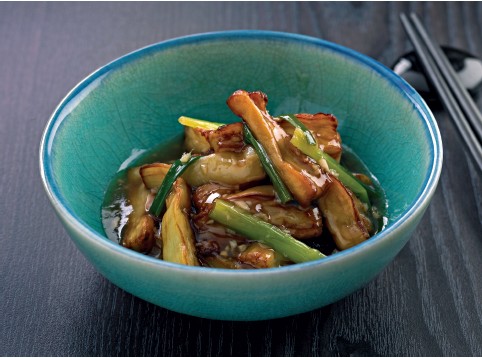
Sweet and Sour Tianjin Cabbage
250 g (8 oz) Chinese (Napa) cabbage, leaves separated and washed, drained dry in a colander
1 tablespoon oil
5 dried chilies, deseeded
1 teaspoon Sichuan peppercorns
2 teaspoons black Chinese vinegar
½ teaspoon salt
2 teaspoons sugar
2 tablespoons water
1 teaspoon sesame oil
1 Cut the cabbage into short lengths
2 Heat the oil in a wok. Add the dried chilies and stir-fry thoroughly. Add the Sichuan peppercorns and mix well.
3 Add the cabbage and stir-fry to mix thoroughly. Stir in the black Chinese vinegar, salt, sugar and water, and fry for another 3–5 minutes.
4 Remove from the heat and drizzle with the sesame oil before serving.
Serves 4–6
Preparation time: 10 mins
Cooking time: 10 mins
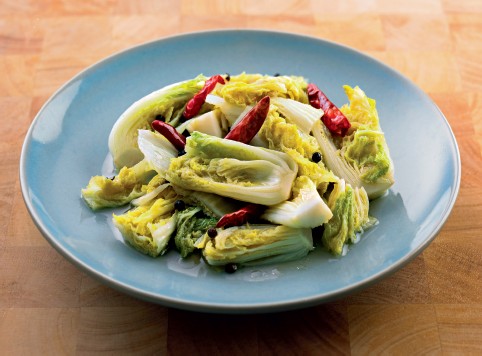
Tofu with Black Bean Sauce
2 cakes soft tofu (about 300 g/10 oz each)
¼ cup (60 ml) oil
1 tablespoon dried prawns, soaked in warm water, drained and chopped
2 tablespoons fermented black bean sauce (dou sze jiang, see note)
2 spring onions, chopped
3 slices ginger
2 cloves garlic, chopped garlic
100 g (½ cup) minced pork
5 tablespoons soy sauce
2 tablespoons rice wine
½ cup (125 ml) chicken stock
1 tablespoon cornflour dissolved in 1 tablespoon of water
2 tablespoons chopped coriander leaves, to garnish
Peppercorn Oil
2 tablespoons Sichuan peppercorns
8 tablespoons oil
1 Make the Peppercorn Oil by heating a frying pan over medium heat. Reduce the heat to low and add the Sichuan peppercorns. Brown the peppercorns, shaking the pan occasionally, until they are aromatic. Set aside to cool. Crush the peppercorns with a mortar or coarsely blend them in a food processor. Heat the oil in a separate saucepan over high heat. Return the crushed peppercorns to the frying pan and pour the oil over. Set aside to cool. Strain the flavored oil and store in a sealed jar at room temperature.
2 Place the tofu in a heat-proof bowl and steam for 10 minutes. Remove, drain and cut into small cubes. Place them on a serving platter and set aside.
3 Heat the oil in a wok over high heat. Add the chopped dried prawns, black bean sauce, spring onions, ginger, garlic and minced pork. Stir-fry for 2 minutes. Add the soy sauce, rice wine and chicken stock. Stir in the cornflour mixture and cook, stirring, until the sauce thickens.
4 Remove from the heat and pour over the tofu cubes. Garnish with the chopped coriander leaves and drizzle with the Peppercorn Oil before serving.
Fermented black bean sauce is a richly-flavored seasoning made from fermented black beans (also called salted black beans)—soybeans that have been fermented and preserved in salt, hence their strong, salty flavor. Mainly used to season a number of dishes, especially fish, beef and chicken. It is sold in jars and can be found in the ethnic or international section of many supermarkets.
Serves 4–6
Preparation time: 10 mins
Cooking time: 20 mins

Tofu Skin with Tender Soy Beans
2 sheets dried tofu skin
250 g (8 oz) tender young soy beans or edamane
2 tablespoons oil
1 teaspoon salt
1 teaspoon sugar
1 teaspoon soy sauce
1 teaspoon rice wine
1 Lay the dried tofu skin flat and cover it with a wet towel until it turns soft and flexible. Cut into thin strips, like noodles and set aside.
2 Bring a pot of water to a boil, add a pinch of salt and boil the tender soy beans until they soften, about 5 minutes, then drain in a colander.
3 Heat the oil in a wok until hot but not smoking, add the pre-boiled soy beans and stir-fry for 2–3 minutes. Then add the tofu skin strips and stir-fry for 2 more minutes. Add the rest of the ingredients and stir quickly to mix, then transfer to a serving plate and serve immediately.
If you cannot find tender soy beans, you may substitute fresh or frozen lima beans. After boiling the lima beans, be sure to rub off the outer skin before stir-frying them. Chopped spring onions may also be added to the wok along with the other seasonings.
Serves 4
Preparation time: 15 mins
Cooking time: 10 mins

Stir-fried Asparagus with Leeks
1 bunch fresh asparagus (about 250 g/ 8 oz)
2 fresh leeks
1 small carrot
3 tablespoons sesame oil
1 teaspoon salt
1 teaspoon sugar
2 teaspoons rice wine
1 Wash the asparagus, peel away the tough outer skin from the lower half of the stalks. Cut each stalk diagonally into 4 pieces.
2 Wash the leeks well, making sure to eliminate the grit within the folds. Then cut diagonally into 4-cm (1½-in) lengths.
3 Cut the carrot in half lengthwise, then slice each half into thin half-mooned shape slices.
4 Heat the sesame oil in a wok until hot but not smoking, add the leeks and stir-fry for 3–4 minutes. Add the carrot, salt, sugar and rice wine and stir-fry for 2 more minutes, then add the asparagus and stir-fry for another 3 minutes. Transfer to a serving plate and serve immediately.
You may use snow peas in place of carrots. Snapped off the ends and remove the strings. Some northern Chinese chefs like to sprinkle toasted sesame seeds over the finished dish.
Serves 4–6
Preparation time: 20 mins
Cooking time: 10 mins
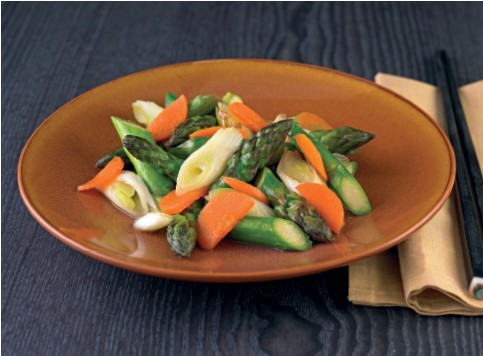
Sweet Ginger Wine Chicken
In this recipe, large chunks of chicken are marinated in a tangy ginger wine, then simmered in an aromatic sweet wine sauce, producing a superb flavor and tender texture. The ginger and wine give this dish warming properties, which makes it a good choice for cold winter weather.
1 whole chicken, preferably free-range, chopped into large chunks, including bone and skin
⅔ cup (150 ml) rice wine steeped with 2 tablespoons grated ginger for 1 hour
15 g (1 cup) dried wood ear black fungus, soaked in hot water for 20 minutes
2 tablespoons oil
10 slices ginger
3 cloves garlic, cut into thin slices
3 spring onions, cut into 2-cm (¾-in) sections
1½ cups (375 ml) rice wine
2½ cups (625 ml) sweet rice wine, sherry, or Japanese mirin
1 teaspoon salt
Sprigs of coriander leaves, to garnish
1 Place the chicken chunks and ginger wine in a bowl, toss well and set aside to marinate for 30–45 minutes. Drain and reserve the ginger wine marinade.
2 Drain the wood ear fungus and cut into bite-sized pieces.
3 Heat the oil in a wok until smoking hot, add the ginger, garlic and spring onions. Stir-fry for 1 minute, then add the drained chicken and stir-fry for another 5 minutes or until the chicken changes color. Add both wines, the reserved ginger wine marinade and salt and bring to a boil. Cover with a lid, reduce the heat and simmer for 15 minutes, then add the wood ear fungus and continue to simmer until the chicken is tender, about 10 more minutes. Remove from the heat and transfer to a deep serving dish, garnish with a few sprigs of coriander leaves and serve immediately.
Instead of wood ear black fungus, you may use black Chinese mushrooms. If you cannot find sweet rice wine, sweet cream sherry or mirin, then use ordinary rice wine or sherry and sweeten it with 1½ tablespoons of sugar or honey.
Serves 4–6
Preparation time: 15 mins + marinating time
Cooking time: 35 mins

Chicken with Cashews
Chicken and cashews has always been a very popular combination in Chinese cuisine. In this northern Chinese version it’s flavored with a slightly sweet soy and sesame oil sauce and cooked over very high heat to seal in the flavor and preserve the tender texture.
2 teaspoons cornflour
½ teaspoon salt
1 egg white, lightly beaten
250 g (8 oz) boneless chicken breasts, cut into chunks
2 tablespoons oil
50g (½ cup) snowpeas
2 tablespoons soy sauce
½ tablespoon sugar
50 g (⅓ cup) toasted cashew nuts
1 tablespoon sesame oil
1 Mix the cornflour, salt and the lightly beaten egg white until well blended. Add the chicken chunks to the mixture and mix until all the chicken is well coated.
2 Heat the oil in a wok until smoking hot, then add the chicken and stir-fry quickly for 2 minutes. Add the snow peas, soy sauce and sugar. Continue to stir-fry for another 5 minutes, then add the toasted cashew nuts and continue to stir-fry for 2 more minutes. Add the sesame oil and stir to mix all the ingredients. Remove from the heat and transfer to a serving platter.
For a spicier flavor, add 3–4 cloves of finely minced garlic to the oil along with the chicken. 3 spring onions cut into 3-cm (1¼-in ) sections may also be added along with the cashew nuts for additional flavor and color.
Serves 4
Preparation time: 15 mins
Cooking time: 10 mins

Pork with Green Peppers and Peanuts
125 g (4 oz) boneless pork shoulder
6 egg whites
3 tablespoons cornflour
3 tablespoons oil
1 green bell pepper, deseeded and cut into 1-cm (½-in) cubes
1 tablespoon peanuts, skinned and deep-fried
¼ teaspoon chili oil (see note)
Sauce
1 tablespoon cornflour
3 tablespoons stock or water
1 tablespoon rice wine
1 tablespoon soy sauce
1 tablespoon salt, or to taste
1 spring onion, finely chopped
¼ teaspoon ginger powder or 1 tablespoon very finely minced ginger
¼ teaspoon sliced garlic
1½ teaspoons sugar
1 Make the Sauce by dissolving the cornflour in the stock or water in a bowl. Stir in the rest of the ingredients and keep stirring until the sugar completely dissolves. Set aside.
2 Wash the pork and cut into small cubes.
3 Beat the egg whites and mix in the cornflour. Add the pork cubes and mix well to coat. Set aside.
4 Heat the oil in a wok over medium-hot heat. Add the pork cubes and stir-fry for about 1 minute, cooking them just long enough to seal in the juices. Turn off the heat and remove the pork cubes with a slotted spoon, reserving the oil in the wok. Set aside.
5 Reheat the reserved oil in the wok. Add the green bell pepper cubes and stir-fry for about 1 minute. Return the pork cubes to the wok. Stir the Sauce to blend it, then add to the wok.
6 Add the deep-fried peanuts and chili oil. Bring the contents to a boil and cook, stirring until the Sauce thickens. Remove from the heat, transfer to a serving platter and serve immediately.
Chili oil is made from dried chilies or chili powder steeped in oil. Bottled chili oil is also available in Asian markets, or you can make your own. Heat ¾ cup (185 ml) of oil in a wok or frying pan and add 1 tablespoon of Sichuan peppercorns and 2 dried chilies (deseeded and sliced). Cook over low heat for 10 minutes, then cool and store in a glass container for 2–3 days. Strain and discard the peppercorns and chilies. Store in an airtight glass jar and keep in a cool place for up to 6 months.
Serves 4
Preparation time: 15 mins
Cooking time: 10 mins
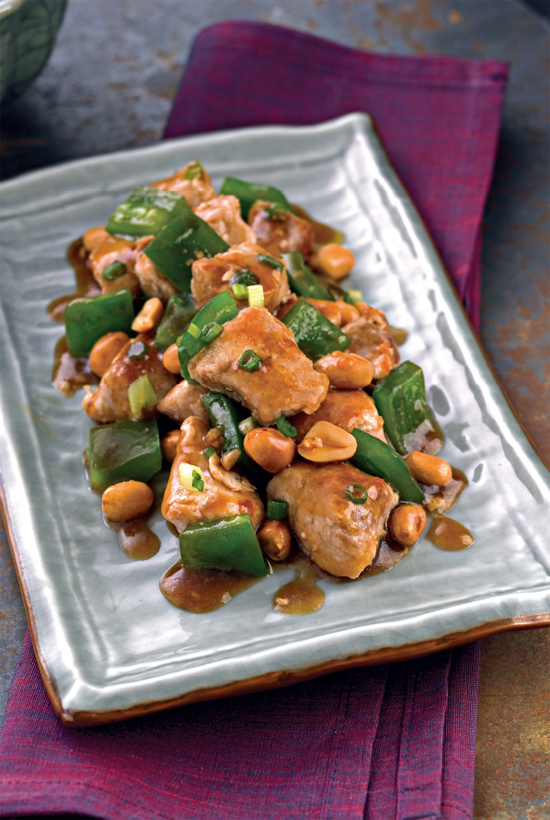
Sliced Pork with Garlic
This recipe works best with “five flower” pork (wu hua zhu rou)—a “marbled” cut of pork that has both lean and fat. Leftovers may be kept in the refrigerator and served the next day.
500 g (1 lb) marbled pork
Sauce
8 cloves garlic, very finely minced
2 tablespoons soy sauce
2 teaspoons sugar
1 teaspoon black Chinese vinegar
3 teaspoons sesame oil
Coriander leaves, to garnish
1 Bring a pot of water to a boil, add the pork. Return to a boil, then lower the heat and simmer for another 35 minutes. Remove the pork with a slotted spoon and set aside in a colander to drain and cool completely.
2 Use a sharp knife to cut the pork, across the grain, into very thin slices, so that each slice has both lean and fat portions. Arrange the sliced pork evenly on a serving platter.
3 Mix all the Sauce ingredients in a bowl until well blended. Drizzle the Sauce evenly over the sliced pork. Serve immediately or chill until ready to serve.
For a spicy flavor, add 1 teaspoon ground black pepper or 1 finely minced red finger-length chili to the sauce.
Serves 6–8
Preparation time: 20 mins
Cooking time: 45 mins
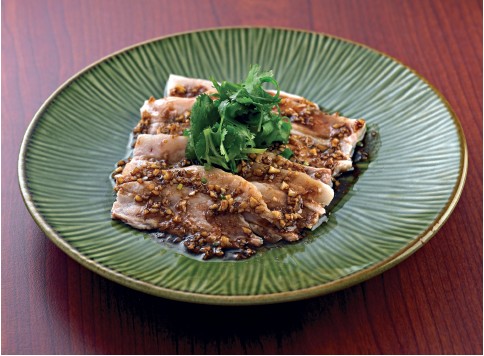
Five Spice Beijing Spareribs
500 g (1 lb) pork spareribs
4 tablespoons soy sauce
2 tablespoons sugar
Oil, for deep-frying
2 spring onions, chopped
2 slices ginger, minced
1 teaspoon rice wine
½ teaspoon fennel seeds
1 teaspoon brown sugar
5 teaspoons rice vinegar
1 teaspoon salt, or to taste
1 Wash the spareribs and chopped into 3-cm (1¼-in) long pieces. Soak in cold water to cover for 5 minutes. Remove, drain and marinate in 2 tablespoons soy sauce for 15 minutes. Drain, dry well and rub with the sugar. Set aside.
2 Heat the oil in a wok over high heat. Add the spareribs and deep-fry until golden brown. Remove with a slotted spoon and set aside. Pour out the oil, leaving only enough oil to cover the bottom of the wok.
3 Reheat the wok and add the spring onions and ginger. Return the spareribs to the wok. Stir in the rice wine, fennel seeds, brown sugar, vinegar, salt and the remaining soy sauce. Stir-fry for about 1 minute. Reduce the heat to low and simmer until the sauce thickens and the meat falls from the bones. Remove and serve hot.
Serves 4
Preparation time: 15 mins
Cooking time: 10 mins

Braised Beef with Spicy Sauce
In most Chinese markets, braised beef may be purchased cooked. If you buy your beef already braised in the market, be sure to also purchase a cup of the braising sauce from the vendor, so you need not prepare the sauce at home.
4 fresh beef shanks
1 red finger-length chili
4 spring onions
5 slices ginger
5 cloves garlic, smashed but not cut
2 cups (500 ml) soy sauce
160 g (1 cup) rock sugar
6 tablespoons rice wine
1 teaspoon salt
3 tablespoons sweet fermented flour paste (tien mien jiang) or hoisin sauce (see note)
2 cups (500 ml) water
1 Chinese stew spice bag (lu hsiang bao, see note)
Sprigs of coriander leaves and finely chopped deseeded red finger-length chilies, to garnish
1 Bring a large pot of water to a boil, add the beef shanks and let it boil for 2 minutes to clean the meat. Remove the beef with a slotted spoon, rinse in cool water and set aside to drain in a colander.
2 Place the beef in a large clean pot, add all the ingredients except the spice bag and garnishes. Bring to a boil. Add the spice bag, cover with a lid, lower the heat to medium-low and simmer for 2 hours. When done, turn off the heat and let the beef shanks cool in the cooking sauce in the pot for at least 1 hour.
3 To serve, remove the beef shanks from the pot, place on a cutting board and cut across the grain into thin slices. Arrange the sliced beef attractively on a serving platter, then drizzle some of the sauce on top. Garnish with sprigs of coriander leaves and chopped red chili, if desired. Extra sauce may be kept in the refrigerator for future use.
4 If you wish to serve this dish the next day, place the entire pot of beef, including the sauce, in the refrigerator overnight and cut immediately before serving the next day.
Tien Mien Jiang, also known as sweet bean sauce, is a thick, black-colored Chinese sauce made with ground fermented yellow soybeans, flour, sugar and salt. Chinese cooks use it as a marinade or condiments for meats. It is used in dishes such as Peking Duck. Hoisin sauce is a good substitute.
If you cannot find Chinese stew spice bags in the market, you can make your own with a few sticks of cinnamon, 1 teaspoon Sichuan peppercorns, a few pieces of dried orange peel, 6 cloves, half a nutmeg and a few slices of licorice root. Tie these into a cheesecloth and add to the cooking sauce. The sliced beef may be garnished with coriander leaves and, for a pungent touch, some finely chopped fresh chilies. If you don’t like beef, the same dish may be prepared with lamb shanks or pork shanks.
Serves 4–6
Preparation time: 15 mins
Cooking time: 3 hours

Marinated Lamb with Garlic Sauce
Lamb is a major ingredient on northern Chinese menus, reflecting culinary influence from the steppes of Mongolia. Lamb also warms the body, making it a popular choice in cold northern climates. Northern Chinese chefs always marinate the lamb first and cook it with plenty of garlic to eliminate any trace of rank flavor.
300 g (10 oz) lamb loin or leg, sliced across the grain and cut into fine slivers
4 tablespoons oil
10 cloves garlic, finely sliced
3 spring onions, cut into 3-cm (1¼-in) sections
1 tablespoon soy sauce
1 tablespoon rice wine
2 teaspoons sesame oil
½ teaspoon salt
25 g (½ cup) chopped coriander leaves, to garnish
Marinade
½ teaspoon salt
1½ teaspoon ground Sichuan peppercorns
2 tablespoons soy sauce
2 teaspoons rice wine
1 teaspoon sesame oil
1 teaspoon sugar
1 teaspoon cornflour
1 Place the lamb together with all the Marinade ingredients in a bowl and mix well. Set aside to marinate for 20–30 minutes.
2 Heat the oil in a wok until smoking hot. Add the sliced garlic, the marinated lamb and stir-fry quickly for about 2 minutes or until the lamb changes color. Add the rest of the ingredients and stir-fry for 1 more minute. Transfer to a platter, garnish with the chopped coriander leaves and serve immediately.
Serves 2–3
Preparation time: 5 mins + 30 mins marinating time
Cooking time: 10 mins

Beef with Star Anise and Ginger
Beef is one of the most popular items on northern Chinese menus. Stewing is a favorite method to prepare beef. This recipe is especially tasty and easy to prepare and it may be cooked in advance.
750 g (1½ lbs) beef loin, brisket or shank
8½ cups (2 liters) water
3 star anise pods
2 tablespoons sugar
¾ cup (185 ml) soy sauce
¾ cup (185 ml) rice wine or sherry
3 tablespoons oil
4 spring onions, cut into 3-cm (1¼-in) sections
6 slices ginger, smashed with handle of knife
1½ teaspoons cornflour dissolved in 3 tablespoons water
1 Cut the beef into 3-cm (1¼-in) cubes. Bring the water to a boil in a large pot, blanch the beef cubes for 2 minutes. Remove the beef with a slotted spoon and set aside to drain in a colander. Reserve the cooking water.
2 Skim away all fat and foam from the water in which the beef was blanched. Add the star anise, sugar, soy sauce and wine, and return to a boil. Lower the heat and let the stock simmer.
3 Heat the oil in a wok until smoking, add the beef cubes, spring onions and ginger. Stir-fry for 3 minutes. Transfer the contents to the simmering stock, cover with a lid and simmer over low heat for 2 hours or until the beef is very tender and the stock is reduced.
4 Add the cornflour mixture to the pot, stir and simmer for another 2 minutes or until the sauce thickens. Transfer the beef together with the sauce to a large shallow bowl and serve.
You may also prepare this dish with lamb loin or shanks. Chopped coriander leaves may be served on the side as a garnish for individual servings. For a pungent flavor, add one whole red finger-length chili, cut in half lengthwise, to the stew pot.
Serves 4–6
Preparation time: 15 mins
Cooking time: 2 hours

Flash-fried Garlic Prawns
The prawns in this dish are fried complete with shells and heads—a traditional Chinese cooking method which not only preserves the natural flavor of the prawns, but also locks in the nutritional factors in the juices. The blend of flavors here is a typically northern Chinese combination, with the accent on garlic.
20 large fresh prawns (about 750 g/1½ lbs), shells and heads intact
4 tablespoons oil
6 cloves garlic, smashed with flat side of cleaver
3 slices ginger, smashed with handle of knife
2 spring onions, cut into 5-cm (2-in) sections
1 tablespoon rice wine
1 teaspoon salt
1 teaspoon ground black pepper
½ cup (125 ml) water
1 Wash the prawns and set aside in a bowl.
2 Heat the oil in a wok until smoking hot, then add the prawns and stir-fry for 3 minutes until they change color. Remove with a slotted spoon, reserving the oil in the wok. Set the prawns aside on a plate.
3 Fry the garlic, ginger and spring onions in the reserved oil for 2–3 minutes to release flavor and aroma into the oil, then remove them with a slotted spoon and discard. Put the prawns back into the hot spicy oil, add the wine, salt and pepper, then add the water and stir-fry until most of the water has evaporated, about 2–3 minutes. Transfer to a serving platter and serve immediately.
Chopped coriander leaves may be used as a garnish. For a more aromatic pungent flavor, ground Sichuan peppercorns may be used instead of black pepper.
Serves 4–6
Preparation time: 20 mins
Cooking time: 10 mins

Tianjin Style Fish
Carp has always been the favorite fresh-water fish on northern Chinese menus. In this recipe the fish is cooked twice to bring out its subtle flavors, eliminating all traces of “fishy” tastes and provide the best possible texture for feasting. This dish is regarded as “haute cuisine” on northern Chinese banquet menu.
1 whole medium fresh carp or trout, scaled and gutted, rinse with cold water and pat dry
1 tablespoon rice wine
1 teaspoon salt
1 teaspoon ground black pepper
2 tablespoons cornflour
1 egg, beaten in a shallow bowl
4 tablespoons oil
3 slices ginger, finely shredded
3 spring onions, finely shredded
80 g (1 cup) finely shredded white turnip (daikon)
1 With a very sharp knife, make 3 diagonal cuts into the flesh on both sides of the fish, taking care not to cut too deeply.
2 Place the fish on a platter and sprinkle both sides with the rice wine, then rub the salt and pepper evenly into the incisions on both sides.
3 Spread the cornflour onto a dry plate big enough to hold the fish, then set both sides of the fish in the cornflour, until the whole fish is coated.
4 Dip the fish into the beaten egg until a thin layer of egg clings to the entire surface of the fish.
5 Heat the oil in a non-stick flat pan until hot, but not smoking, then fry both sides of the fish until golden brown.
6 Transfer the fried fish to a heat-resistant plate and sprinkle the shredded ginger, spring onion and turnip evenly on top.
7 Bring the water in a steamer to a full boil. Place the plate of fish on the steamer rack and steam for 8–10 minutes. Remove from the steamer and serve immediately.
Serves 4–6
Preparation time: 20 mins
Cooking time: 15 mins
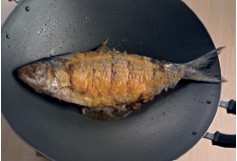
Fry both sides of the fish until golden brown.
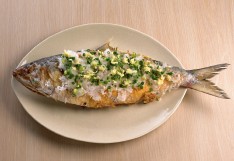
Transfer the fried fish to a heat-resistant plate and sprinkle the shredded ginger, spring onion and turnip evenly on top.

Steamed Lotus Seeds in Sweet Syrup
Lotus seeds appear in many Chinese sweet courses, due to their fine flavor and crunchy texture. They also have potent medicinal properties, including tonic benefits for the heart and calming effects on the nervous system. They are also renowned in China for their aphrodisiac properties.
250 g (1⅔ cups) dried lotus seeds, pre-soaked in cold water for 30 minutes
6¼ cups (1.5 liters) boiling water
130 g (⅔ cup) sugar
1 Drain the lotus seeds. Place them in a pot with enough cold water to cover them. Bring to a boil and simmer for 3 more minutes, then drain again. When cool, peel and use a pin or toothpick to remove the bitter dark strand at the core of each seed. Place the lotus seeds in a heat-proof dish with half of the boiling water. Place the dish on a rack in a steamer and steam for 30–40 minutes, until they are tender, then remove from the steamer.
2 Place the sugar in a serving bowl and add the remaining boiling water, stirring until the sugar completely dissolves. Then add the steamed lotus seeds, along with the water they were steamed in, to the sugared water. Serve hot or chill in the refrigerator and serve cold.
Serves 4–6
Preparation time: 20 mins
Cooking time: 50 mins

Sweet Almond Cream Dessert
Almonds are another favorite ingredient for desserts on northern Chinese menus. They are among the most nutritionally—containing most of the essential amino acids, fatty acids and plenty of calcium and magnesium. They are also easy to digest and do not acidify the digestive system, as most other nuts do.
150 g (1½ cups) blanched almonds
5¼ cups (1.25 liters) water
100 g (½ cup) sugar
½ cup (125 ml) cream (or substitute evaporated milk or coconut cream)
2 teaspoons cornflour dissolved in 2 tablespoons water
1 Put the almonds in an oven on low heat for about 15 minutes until they are completely dry, but do not change color, then grind them in a food processor or coffee grinder.
2 Bring the water to a boil, add the sugar and the ground almond, stir continuously until the water returns to a boil, then add the cornflour mixture and stir continuously for 4 more minutes. Add the cream and stir well. Serve hot or chilled.
Serves 4–6
Preparation time: 15 mins
Cooking time: 20 mins
